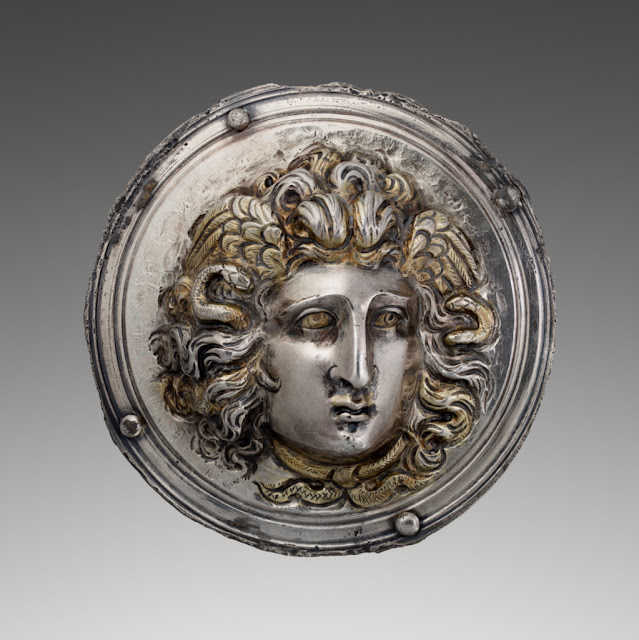The beautification of Medusa
While ancient Greek vase-painters and relief carvers of the Archaic Period imagined Medusa and her two immortal sisters as having monstrous form that is both male and female, human and animal, with round faces, wide eyes, beards, and gaping mouths with extended tongues and gnashing, sharp teeth, sculptors and vase-painters of the fifth century BCE began to envisage her as being beautiful as well as terrifying and she loses the frightful teeth and beard but retains her wild hair and her uncompromising riveting gaze. In an ode written in 490 BCE, Pindar already speaks of "fair-cheeked Medusa". Art historians attribute this to the emergence of a new artistic emphasis on the ideal form that codified standards of perfection and beauty.
In fact, the depiction of a snake-haired Medusa does not become widespread until much later in the 1st century BCE, further perpetuated by the Roman poet Ovid in his Metamorphoses (4.794–803), who explains that Medusa was originally a beautiful maiden, but when Poseidon had sex with her in "Minerva's (i.e. Athena's) temple, Athena punished Medusa by transforming her beautiful hair into horrible snakes.
I found this an interesting side note: a number of early classics scholars interpreted the myth of Medusa and her beheading by the hero Perseus as quasi-historical, a sublimated memory of an actual invasion. Comparative mythologist Joseph Campbell proposed that in the early thirteenth century BCE, a historic rupture or sociological trauma actually occurred in which the Hellenes overran Athena's chief shrines and stripped her priestesses of their apotropaic Gorgon masks.
Read more about it in the Metropolitan Museum of Art's article, "Medusa in Ancient Greek Art." https://www.metmuseum.org/toah/hd/medu/hd_medu.htm
Image: Gilded silver roundel thought to have been a bridle ornament, Roman, 150-235 CE, now in the collections of the J. Paul Getty Museum. Image courtesy of the museum.




Comments
Post a Comment